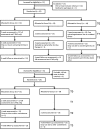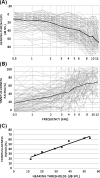Effects of frequency discrimination training on tinnitus: results from two randomised controlled trials
- PMID: 22476724
- PMCID: PMC3387303
- DOI: 10.1007/s10162-012-0323-6
Effects of frequency discrimination training on tinnitus: results from two randomised controlled trials
Abstract
That auditory perceptual training may alleviate tinnitus draws on two observations: (1) tinnitus probably arises from altered activity within the central auditory system following hearing loss and (2) sound-based training can change central auditory activity. Training that provides sound enrichment across hearing loss frequencies has therefore been hypothesised to alleviate tinnitus. We tested this prediction with two randomised trials of frequency discrimination training involving a total of 70 participants with chronic subjective tinnitus. Participants trained on either (1) a pure-tone standard at a frequency within their region of normal hearing, (2) a pure-tone standard within the region of hearing loss or (3) a high-pass harmonic complex tone spanning a region of hearing loss. Analysis of the primary outcome measure revealed an overall reduction in self-reported tinnitus handicap after training that was maintained at a 1-month follow-up assessment, but there were no significant differences between groups. Secondary analyses also report the effects of different domains of tinnitus handicap on the psychoacoustical characteristics of the tinnitus percept (sensation level, bandwidth and pitch) and on duration of training. Our overall findings and conclusions cast doubt on the superiority of a purely acoustic mechanism to underpin tinnitus remediation. Rather, the nonspecific patterns of improvement are more suggestive that auditory perceptual training affects impact on a contributory mechanism such as selective attention or emotional state.
Figures





Similar articles
-
The relationship between tinnitus pitch and the edge frequency of the audiogram in individuals with hearing impairment and tonal tinnitus.Hear Res. 2010 Mar;261(1-2):51-6. doi: 10.1016/j.heares.2010.01.003. Epub 2010 Jan 12. Hear Res. 2010. PMID: 20103482
-
Auditory discrimination training for tinnitus treatment: the effect of different paradigms.Eur Arch Otorhinolaryngol. 2010 Jul;267(7):1067-74. doi: 10.1007/s00405-009-1182-6. Epub 2010 Jan 1. Eur Arch Otorhinolaryngol. 2010. PMID: 20044759 Clinical Trial.
-
Auditory evoked magnetic fields in individuals with tinnitus.Hear Res. 2013 Aug;302:50-9. doi: 10.1016/j.heares.2013.04.006. Epub 2013 Apr 29. Hear Res. 2013. PMID: 23639335 Free PMC article.
-
Plasticity of tonotopic maps in humans: influence of hearing loss, hearing aids and cochlear implants.Acta Otolaryngol. 2010 Mar;130(3):333-7. doi: 10.3109/00016480903258024. Acta Otolaryngol. 2010. PMID: 19845491 Review.
-
Cortical reorganisation and tinnitus: principles of auditory discrimination training for tinnitus management.Eur Arch Otorhinolaryngol. 2009 Jan;266(1):9-16. doi: 10.1007/s00405-008-0757-y. Epub 2008 Jun 28. Eur Arch Otorhinolaryngol. 2009. PMID: 18587591 Review.
Cited by
-
A scientific cognitive-behavioral model of tinnitus: novel conceptualizations of tinnitus distress.Front Neurol. 2014 Oct 6;5:196. doi: 10.3389/fneur.2014.00196. eCollection 2014. Front Neurol. 2014. PMID: 25339938 Free PMC article. Review.
-
Agreement and reliability of tinnitus loudness matching and pitch likeness rating.PLoS One. 2014 Dec 5;9(12):e114553. doi: 10.1371/journal.pone.0114553. eCollection 2014. PLoS One. 2014. PMID: 25478690 Free PMC article. Clinical Trial.
-
Frequency Discrimination Training With and Without Game Format to Treat Tinnitus: A Systematic and Meta-Analysis Study.Indian J Otolaryngol Head Neck Surg. 2024 Dec;76(6):5025-5034. doi: 10.1007/s12070-024-04986-0. Epub 2024 Aug 20. Indian J Otolaryngol Head Neck Surg. 2024. PMID: 39559083
-
Long-term effects of the "Heidelberg Model of Music Therapy" in patients with chronic tinnitus.Int J Clin Exp Med. 2012;5(4):273-88. Epub 2012 Aug 22. Int J Clin Exp Med. 2012. PMID: 22993646 Free PMC article.
-
Subtyping Somatic Tinnitus: A Cross-Sectional UK Cohort Study of Demographic, Clinical and Audiological Characteristics.PLoS One. 2015 May 21;10(5):e0126254. doi: 10.1371/journal.pone.0126254. eCollection 2015. PLoS One. 2015. PMID: 25996779 Free PMC article.
References
Publication types
MeSH terms
Grants and funding
LinkOut - more resources
Full Text Sources
Medical
Miscellaneous

